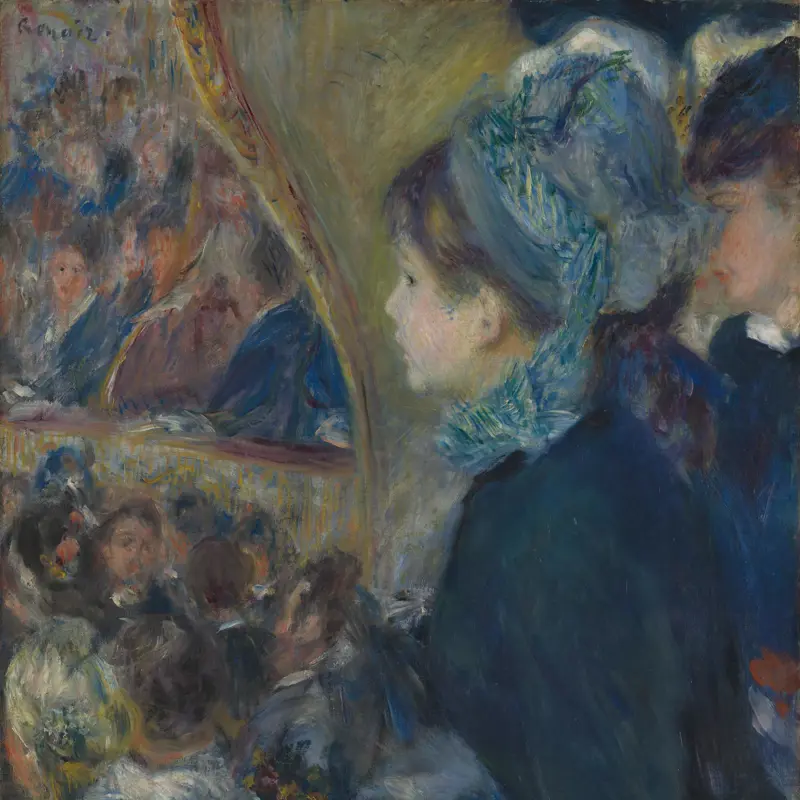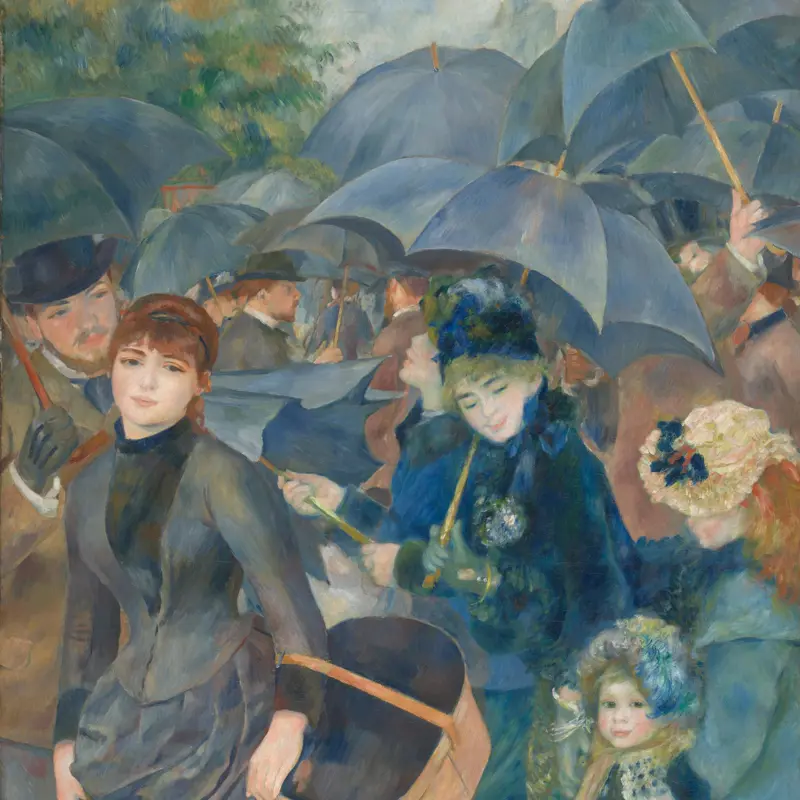Pierre-Auguste Renoir, 'Dancing Girl with Castanets', 1909
About the work
Overview
This picture, together with its companion piece Dancing Girl with Tambourine (also in the National Gallery’s collection), was made to decorate the dining room of the Paris apartment of one of Renoir’s most important clients, Maurice Gangnat. Of the two dancers, this figure has the more animated pose. Her foot is raised and Renoir has created a long, sinuous line up through her leg and arms to suggest her turns and twists as she clacks the castanets. The way the edges of her sheer, shimmering costume blur into the vibrant colours of the background also enhances the impression of movement.
Renoir used Georgette Pigeot, a dressmaker who often posed for him, to model the body of the dancer. The head of this figure, however, is that of Gabrielle Renard, nursemaid and housekeeper for the Renoir family, who was one also of his favourite models. Her costume has elements of oriental or near-Eastern style (in the short, gold-coloured bodice, for example), but the red flowers in her hair are reminiscent of Spain, as are the castanets.
Key facts
Details
- Full title
- Dancing Girl with Castanets
- Artist
- Pierre-Auguste Renoir
- Artist dates
- 1841 - 1919
- Part of the series
- Pair of Dancing Girls with Musical Instruments
- Date made
- 1909
- Medium and support
- oil on canvas
- Dimensions
- 155 × 64.8 cm
- Inscription summary
- Signed; Dated
- Acquisition credit
- Bought, 1961
- Inventory number
- NG6318
- Location
- Not on display
- Collection
- Main Collection
Provenance
Additional information
Text extracted from the ‘Provenance’ section of the catalogue entry in Martin Davies, with additions and some revisions by Cecil Gould, ‘National Gallery Catalogues: French School: Early 19th Century, Impressionists, Post-Impressionists, etc.’, London 1970; for further information, see the full catalogue entry.
Exhibition history
-
2009Renoir au XXe SiècleGaleries Nationales du Grand Palais21 September 2009 - 4 January 2010Los Angeles County Museum of Art14 February 2010 - 9 May 2010Philadelphia Art Museum12 June 2010 - 5 September 2010
-
2018Loan to Amgueddfa Cymru - National Museum WalesAmgueddfa Cymru — National Museum Wales14 March 2018 - 12 August 2018
-
2021Impressionist Decorations: The birth of modern décorMusée de l'Orangerie1 March 2022 - 11 July 2022
Bibliography
-
1912J. Meier-Graefe, Auguste Renoir, Paris 1912
-
1923P. Jamot, 'Renoir', Gazette des beaux-arts, VIII, 1923
-
1925R. Bouyer, 'Les Renoir de la collection Gangnat', Gazette des beaux-arts, 1925, pp. 246-50
-
1929J. Meier-Graefe, Renoir, Leipzig 1929
-
1931H. Bérenger, Exposition coloniale internationale de Paris: Beaux-arts, mai-novembre 1931, Paris 1931
-
1931A. Alexandre, 'Au musée des colonies', Renaissance, 9, 1931, pp. 265-72
-
1933Musée de l'Orangerie, Exposition: Renoir, 1841-1919, Paris 1933
-
1937Rosenberg and Helft, Loan Exhibition of Renoir (exh. cat., 5 May 5 1937 - 12 June 1937), London 1937
-
1944M. Drucker, Renoir, Paris 1944
-
1955Galerie Durand-Ruel, Renoir: Collection Maurice Gangnat, Paris 1955
-
1962The National Gallery, The National Gallery: January 1960 - May 1962, London 1962
-
1970Davies, Martin, and Cecil Gould, National Gallery Catalogues: French School: Early 19th Century, Impressionists, Post-Impressionists etc., London 1970
-
1978A. Callen, Renoir, London 1978
-
1978C. Gould, The Draped Figure, Themes and Painters in the National Gallery 2, 2nd edn, London 1978
-
1982W. Gaunt, Renoir, Oxford 1982
-
1984B.E. White, Renoir: His Life, Art and Letters, New York 1984
-
1987N. Wadley (ed.), Renoir: A Retrospective, New York 1987
-
1993C. Riopelle, Great French Paintings from the Barnes Foundation: Impressionist, Post-Impressionist and Early Modern, New York 1993
-
1998H. Luckett, Henry Moore and the National Gallery (exh. cat. The National Gallery, 3 April - 31 May 1998), Chicago 1998
-
2000R.L. Herbert, Nature's Workshop: Renoir's Writings on the Decorative Arts, New Haven 2000
-
2001
C. Baker and T. Henry, The National Gallery: Complete Illustrated Catalogue, London 2001
-
2001G. Néret, Renoir: Painter of Happiness, 1841-1919, Cologne 2001
-
2003B. Alaoui, De Delacroix à Renoir: L'Algérie des peintres (exh. cat. l'Institut du monde arabe, 7 October 2003 - 18 January 2004), Paris 2003
-
2003R. Benjamin, Renoir and Algeria (exh. cat. Sterling and Francine Clark Art Institute, 16 February - 11 May 2003), New Haven 2003
-
2005A. Dumas and J. Collins, Renoir's Women, (exh. Cat. Columbus Museum of Art, 23 September 2005 - 8 January 2006), New York 2005
-
2008K. Adler, Renoir: La maturità tra classico e moderno (exh. cat. Complesso del Vittoriano, 8 March - 29 June 2008), Milan 2008
About this record
If you know more about this work or have spotted an error, please contact us. Please note that exhibition histories are listed from 2009 onwards. Bibliographies may not be complete; more comprehensive information is available in the National Gallery Library.
Images
About the series: Pair of Dancing Girls with Musical Instruments
Overview
These two pictures of dancers in exotic costumes are near life-size. They were were made as part of the decorations of an apartment at 24 Avenue de Friedland in central Paris, which belonged to Maurice Gangnat, a wealthy steel magnate and art collector and one of Renoir’s most discerning clients. Made to hang on either side of a mirror above the fireplace in the dining room, they belong to a tradition of decorative art used to enliven architectural features with painted figures, often in poses which mimicked sculptural forms.
The paintings were made late in Renoir’s career, when he was 67 or 68 years old, though as a youthful apprentice he had trained as a decorative artist. The costumes of both dancers have oriental – or near-Eastern – overtones, especially the slippers and short gold-coloured bodices, and the harem pants worn by the woman in Dancing Girl with Tambourine.













